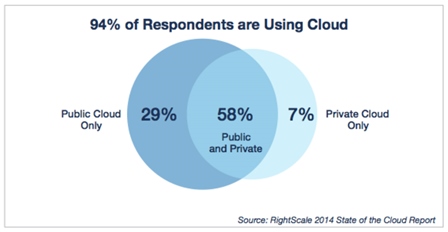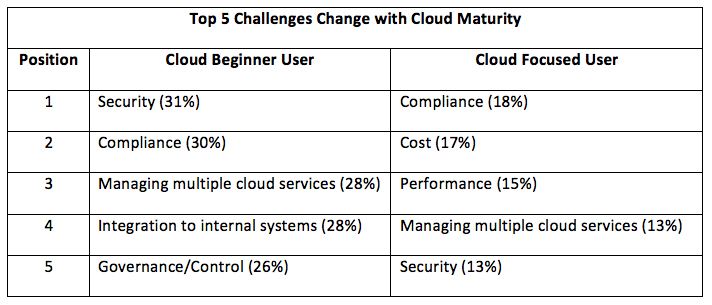Summarizing the 2014 State of the Cloud

Al Kovalick
Each week the big cloud vendors generate enough heat and noise to confuse most onlookers. One relatively impartial observer of the scene is the vendor RightScale. The company offers services to manage and govern resources across public, private and hybrid clouds. In March 2014, they published their annual “The 2014 State of the Cloud Report.”
The report summarizes a survey of 1,068 technical professionals across a broad range of organizations about their adoption of cloud computing. The survey includes 254 enterprise and 814 small/medium businesses.
This column will highlight the report’s key findings. For a more detailed view, download the free report at www.rightscale.com. The respondents included have four levels of experience: cloud watchers, cloud beginners, cloud explorers and cloud focused.
The first group is not participating yet, but considering it, while the last group is heavily using cloud infrastructure. Only 6 percent had no plans. The results are generic and not media facility specific. Nonetheless, many of the lessons apply to our industry.

Fig. 1
HIGHLIGHTS
Fig. 1 shows some interesting findings: 94 percent of respondents are using the cloud in some capacity or will do so soon. The private/public combination is most popular. Private clouds include in-house systems based on “cloud management platforms” such as CloudStack, VMware vCloud Director or Eucalyptus.
The professional video industry's #1 source for news, trends and product and tech information. Sign up below.
Most companies don’t solely depend on the public cloud to run their businesses. A hybrid cloud implementation allows companies to choose the best of private and public based on business needs. One popular mode is to use public clouds to execute heavy workload overflows; else the in-house cloud does all the work.
For media, a facility could use the public cloud for AV transcoding, Web apps (SaaS) for business applications (HR, accounting, scheduling, inventory) and other non-bandwidth-hungry operations, proxy storage, file storage, simple cuts editing, logging and even full blown MAM operations.
Based on your workflows there are likely many other application spaces for cloud use. Rather than take a pessimistic approach to cloud usage, take an optimistic “cloud first” tactic and determine when not to use the cloud.
In the early days of the cloud, players touted the advantage of cost and accounting methods as a primary value; this was often framed as a CapEx versus OpEx tradeoff. In 2014, the top four cloud benefits were: greater scalability and access to infrastructure (52 percent), faster time to market with a product (46 percent), geographic reach (37 percent), and cost savings (34 percent). Many public cloud benefits can’t be achieved any other way, so cost becomes less of a driver.
One of my favorite findings (see Fig. 2, respondents can choose more than one choice) is how the “cloud challenges” rank comparing cloud beginners with cloud-focused users. Security and loss of data was hot button No. 1 during the early days of the cloud. Interestingly, security is still the No. 1 worry for the beginner while this ranks fifth with the experienced user.

Fig. 2
Each year, cloud vendors are doing more to reduce the security concerns. Who has a more experienced security staff; Google, Amazon or your in-house staff? In reality, security is a shared responsibility between user and cloud provider, and experienced users appreciate this more than the novice. Interesting, too, is that performance is not a high concern for the novice, while the seasoned user appreciates that the shared resources model of the cloud makes this a challenge, but still achievable.
WHAT CLOUD?
When responders were asked what public cloud they were using to run workloads, the order was: Amazon Web Services (AWS), Rackspace, Google App Engine, Microsoft Azure, IBM/Softlayer and others. AWS has a wide margin at 54-percent usage of the entire public cloud market.
It’s interesting to watch the fast horse race between AWS, Google and Microsoft. These top-tier players are constantly innovating for the benefit of customers and to stay competitive. Of course, there are other players such as Verizon, CSC, VMware, Cisco and HP and these are positioning themselves for the top tier.
Bottom line, companies are finding value in the cloud across a wide range of workflows. Media companies have the burden of some flows requiring huge connect bandwidths and processing power. However, with prudent resource usage and finding sweet spots for migration, use of private and public cloud offers benefits beyond what traditional AV infrastructure offers.
After digesting all the responses from the 1,068 users, the report concludes with some takeaways. “Organizations are seeing significant benefits from their cloud usage and the barriers to adoption are rapidly disappearing. As a result, each step companies take in their cloud journey delivers increasing value”. Wrapping-up, other findings are:
• Identify your strategy and approach to the cloud;
• Develop a cloud governance model;
• Ensure alignment between business units and IT;
• Explore cloud options and alternatives; and
• Find opportunities to expand your cloud workloads
The report should encourage media enterprises, large and small, to understand and apply the cloud where it makes sense. Having a “cloud first” attitude is a good start towards finding success in the cloud. Don’t let the hurdles of real-time AV or massive data stop your progress. Experience shows that starting with small steps is wise. The media infrastruture of the future will have a cloud imprint so start now, if you have not already, and get your feet wet.
Al Kovalick is the founder of Media Systems consulting in Silicon Valley. He is the author of “Video Systems in an IT Environment (2nd ed).” He is a frequent speaker at industry events and a SMPTE Fellow. For a complete bio and contact information, visitwww.theAVITbook.com.

